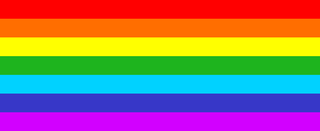
A gay village, also known as a gayborhood, is a geographical area with generally recognized boundaries that is inhabited or frequented by many lesbian, gay, bisexual, transgender, and queer (LGBT) people. Gay villages often contain a number of gay-oriented establishments, such as gay bars and pubs, nightclubs, bathhouses, restaurants, boutiques, and bookstores.

A rainbow flag is a multicolored flag consisting of the colors of the rainbow. The designs differ, but many of the colors are based on the seven spectral colors of the visible light spectrum.
This gallery of sovereign state flags shows the national or state flags of sovereign states that appear on the list of sovereign states. For flags of other entities, please see gallery of flags of dependent territories. Each flag is depicted as if the flagpole is positioned on the left of the flag, except for those of the Islamic Emirate of Afghanistan, Iran, Iraq, and Saudi Arabia, which are depicted with the hoist to the right.
This is a list of notable events in the history of LGBT rights that took place in the year 1978.
The Sisters of Perpetual Indulgence (SPI), also called Order of Perpetual Indulgence (OPI), is a charitable, protest, and street performance movement that uses drag and religious imagery to satirize issues of sex, gender, and morality and fundraise for charity. In 1979, a small group of gay men in San Francisco began wearing the attire of Catholic nuns in visible situations using camp to promote various social and political causes in the Castro District.

The leather pride flag is a symbol used by the leather subculture since the 1990s. It was designed by Tony DeBlase, and was quickly embraced by the gay leather community. It has since become associated with leather in general and also with other kink and fetish subcultures such as the BDSM community.
Transgender flags are used by people, organizations and communities to represent pride, diversity, rights and/or remembrance within the transgender community. Usage is similar to the original Rainbow flag but specific to the transgender community. The best-known design is a pride flag of five horizontal stripes of three colors in the order light blue, light pink, white, light pink, and light blue. There are several alternatives to this flag, and others continue to be suggested.
Over the course of its history, the LGBT community has adopted certain symbols for self-identification to demonstrate unity, pride, shared values, and allegiance to one another. These symbols communicate ideas, concepts, and identity both within their communities and to mainstream culture. The two symbols most recognized internationally are the pink triangle and the rainbow flag.

Lesbian, gay, bisexual, and transgender (LGBT) people in Sudan face significant challenges not experienced by non-LGBT residents. Homosexual activity in Sudan is illegal for both men and women.

The rainbow flag or pride flag is a symbol of LGBT pride and LGBT social movements. The colors reflect the diversity of the LGBT community and the spectrum of human sexuality and gender. Using a rainbow flag as a symbol of LGBT pride began in San Francisco, California, but eventually became common at LGBT rights events worldwide.

LGBT pride is the promotion of the self-affirmation, dignity, equality, and increased visibility of lesbian, gay, bisexual, and transgender (LGBT) people as a social group. Pride, as opposed to shame and social stigma, is the predominant outlook that bolsters most LGBT rights movements. Pride has lent its name to LGBT-themed organizations, institutes, foundations, book titles, periodicals, a cable TV channel, and the Pride Library.

Gilbert Baker was an American artist, designer, and activist, best known as the creator of the rainbow flag.

The Pacific Center for Human Growth, or simply the Pacific Center, is a community center focusing on LGBT people. The center operates from a Victorian house on Telegraph Avenue south of the University of California in Berkeley, California.

The LGBT community in Metro Detroit is centered in Ferndale, Michigan, as of 2007. As of 1997, many LGBT people live in Ferndale, Pleasant Ridge, and Royal Oak. Model D stated in 2007 that there are populations of gays and lesbians in some Detroit neighborhoods such as East English Village, Indian Village, Lafayette Park, and Woodbridge and that the concentration of gay bars in Detroit is "decentralized".

The lesbian, gay, bisexual and transgender (LGBT) community in San Francisco is one of the largest and most prominent LGBT communities in the United States, and is one of the most important in the history of American LGBT rights and activism alongside New York City. The city itself has been described as "the original 'gay-friendly city'". LGBT culture is also active within companies that are based in Silicon Valley, which is located within the southern San Francisco Bay Area.











